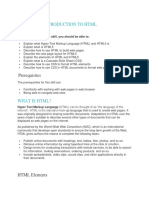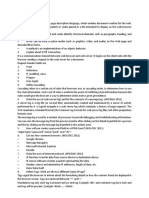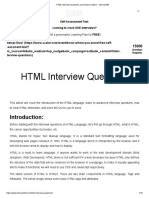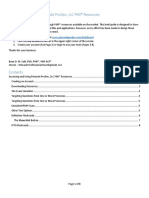0 ratings0% found this document useful (0 votes)
5 viewsHTML Interview Questions
Uploaded by
spyki8888Copyright
© © All Rights Reserved
Available Formats
Download as DOCX, PDF, TXT or read online on Scribd
0 ratings0% found this document useful (0 votes)
5 viewsHTML Interview Questions
Uploaded by
spyki8888Copyright
© © All Rights Reserved
Available Formats
Download as DOCX, PDF, TXT or read online on Scribd
You are on page 1/ 9
HTML INTERVIEW QUESTIONS
1. What does HTML stand for?
● HTML stands for Hypertext Markup Language.
2. What is the use of HTML?
● HTML is the standard markup language it is used for creating Web
pages , HTML is used to create the structure and content of web
pages . It consists of a series of elements. HTML elements tell the
browser how to display the content .
3. What are the different versions of HTML?
● HTML, HTML 4.01, XHTML, HTML5.
4. What is the latest version of HTML?
● HTML5.
5. What are tags in HTML?
● Tags are the fundamental building blocks of HTML. Almost all tags
contain two parts, an opening, and a closing tag.
6. What is an element in HTML?
● An element consists of an opening tag, content, and a closing tag, if
applicable.
7. What is an attribute in HTML?
● An attribute provides additional information about an element and is
defined within the opening tag.
8. What is the purpose of a DOCTYPE declaration?
● It specifies the version of HTML used in the document to the browser.
9. What is the structure of an HTML document?
<!DOCTYPE html>
<html>
<head>
</head>
<body>
</body>
</html>
10.What is the purpose of the <head> tag in HTML?
● It contains meta-information about the HTML document, such as the
title, character set, and CSS or JavaScript links.
HTML Tags:
11.Explain the <div> tag in HTML.
● It is a block-level element used to group content and apply styles.
12.Explain the <span> tag in HTML.
● It is an inline element used to apply styles to a specific part of the text.
13.What is the purpose of the <p> tag?
● It defines a paragraph.
14.How do you create headings in HTML?
● Using <h1> to <h6> tags.
15.Explain the <a> tag and its attributes.
● It creates hyperlinks. Attributes include href, target, and title.
16.How do you create a hyperlink in HTML?
● Using the <a> tag with the href attribute.
17.What is the difference between absolute and relative URLs?
● Absolute URLs include the full path, while relative URLs specify the path
relative to the current page.
18.How do you create an image in HTML?
● Using the <img> tag with the src attribute.
19.Explain the <img> tag and its attributes.
● It embeds images. Attributes include src, alt, width, and height.
20.What is the purpose of the <alt> attribute in the <img> tag?
● It specifies alternative text for the image, which is displayed if the image
fails to load.
21.How do you create a line break in HTML?
● Using the <br> tag.
22.Explain the <br> tag.
● It inserts a line break in the text.
23.How do you create a horizontal line in HTML?
● Using the <hr> tag.
24.Explain the <hr> tag.
● It creates a horizontal rule or line.
25.What is the purpose of the <strong> and <em> tags?
● <strong> is used to highlight important text, and <em> is used for
emphasizing text.
26.What is the <blockquote> tag used for?
● It indicates that the enclosed text is a longer quotation.
27.How do you create a list in HTML?
● Using <ul> for unordered lists and <ol> for ordered lists.
28.Explain the <ul> and <ol> tags.
● <ul> creates an unordered list, and <ol> creates an ordered list.
29.How do you create a table in HTML?
● Using the <table>, <tr>, <td>, and <th> tags.
30.Explain the <table>, <tr>, <td>, and <th> tags.
● <table> defines a table, <tr> defines a row, <td> defines a cell, and <th>
defines a header cell.
Forms:
31.What is the purpose of the <form> tag?
● It defines an HTML form to collect user input.
32.How do you create a form in HTML?
● Using the <form> tag.
33.Explain the <input> tag and its types.
● <input> creates form controls. Types include text, password, checkbox,
radio, etc.
34.What is the difference between the GET and POST methods?
● GET appends form data to the URL, while POST sends data in the request
body.
35.How do you create a text input field?
● <input type="text">
36.How do you create a password input field?
● <input type="password">
37.How do you create a checkbox?
● <input type="checkbox">
38.How do you create a radio button?
● <input type="radio">
39.How do you create a dropdown list?
● Using the <select> and <option> tags.
40.How do you create a submit button?
● <input type="submit">
41.How do you create a reset button?
● <input type="reset">
42.What is the purpose of the <label> tag?
● It defines a label for an input element.
43.How do you associate a label with an input field?
● By using the for attribute in <label> and the id attribute in the
corresponding input field.
44.Explain the <textarea> tag.
● It creates a multiline text input field.
Semantic HTML:
45.What is semantic HTML?
● It is using HTML tags that convey meaning about the content they
contain.
46.Why is semantic HTML important?
● It improves accessibility, search engine optimization, and code
readability.
47.Give examples of semantic HTML tags.
● <header>, <footer>, <nav>, <article>, <section>, <aside>, <main>.
48.Explain the <header> and <footer> tags.
● <header> represents introductory content or a group of navigational
links. <footer> represents a footer for its nearest section.
49.Explain the <nav> tag.
● It defines navigation links.
50.What is the purpose of the <article> tag?
● It defines an independent, self-contained content.
51.What is the purpose of the <section> tag?
● It defines a thematic grouping of content.
52.What is the purpose of the <aside> tag?
● It represents content aside from the content it is placed in.
53.Explain the <main> tag.
● It represents the main content of the document.
54.How do you create a semantic HTML5 document structure?
● By using <header>, <nav>, <main>, <section>, <article>, <aside>, and
<footer> tags appropriately.
HTML5 Features:
55.What are the new features introduced in HTML5?
● Canvas, audio/video elements, local storage, geolocation, semantic
elements, etc.
56.Explain the <canvas> tag.
● It is used to draw graphics using JavaScript.
57.What is the purpose of the <audio> and <video> tags?
● They are used to embed audio and video content, respectively.
58.How do you embed audio and video in HTML5?
● Using the <audio> and <video> tags with the src attribute.
59.What is the purpose of the <details> and <summary> tags?
● They are used to create collapsible content sections.
60.Explain the <figure> and <figcaption> tags.
● <figure> is used to group media content, and <figcaption> provides a
caption for the content.
61.What is the purpose of the <progress> tag?
● It represents the progress of a task.
62.How do you create a progress bar in HTML5?
● Using the <progress> tag with the value attribute.
63.What is the purpose of the <meter> tag?
● It represents a scalar measurement within a known range.
64.How do you create a meter in HTML5?
● Using the <meter> tag with the value and min/max attributes.
65.What is the purpose of the <datalist> tag?
● It provides a list of predefined options for input elements.
66.How do you create a datalist in HTML5?
● Using the <datalist> tag with <option> child elements.
Accessibility:
67.What is web accessibility?
● Web accessibility ensures that websites and web applications are usable
by people with disabilities.
68.Why is web accessibility important?
● It ensures equal access to information and services for everyone.
69.What are some common accessibility features in HTML?
● Providing alt attributes for images, using semantic HTML elements,
creating accessible forms, etc.
70.How do you create accessible forms?
● By using appropriate labels, providing instructions, and ensuring proper
tab order.
71.What is the purpose of the alt attribute in the <img> tag?
● It provides alternative text for images for accessibility and when the
image fails to load.
72.How do you ensure images are accessible to screen readers?
● By providing descriptive alt attributes for images.
73.How do you create accessible tables?
● By using appropriate table headers (<th>), captions (<caption>), and
summary attributes.
74.What is the purpose of the <title> tag?
● It defines the title of the HTML document, which appears in the browser's
title bar or tab.
75.How do you create accessible links?
● By using descriptive link text and avoiding generic phrases like "click
here."
Meta Tags and SEO:
76.What is the purpose of the <meta> tag?
● It provides metadata about the HTML document, such as character
encoding, viewport settings, and SEO information.
77.How do you specify the character encoding in HTML?
● By using the charset attribute in the <meta> tag within the <head>
section.
78.What is the viewport meta tag used for?
● It controls the layout and scaling of the viewport on mobile browsers.
79.How do you specify keywords and descriptions for SEO?
● By using the keywords and description meta tags.
80.What is the purpose of the robots meta tag?
● It instructs search engine crawlers on how to index and display the page
content.
81.How do you specify the canonical URL?
● By using the rel="canonical" attribute in the <link> tag.
82.What is microdata and how is it used for SEO?
● Microdata is a way to provide additional context about the content on a
web page, which can improve SEO.
83.What are rich snippets?
● They are enhanced search results displayed by search engines, often
including additional information like ratings and reviews.
Responsive Web Design:
84.What is responsive web design?
● It is an approach to designing websites that adapt to different screen
sizes and devices.
85.How do you make a website responsive?
● By using fluid grids, flexible images, and media queries.
86.What is a media query?
● It is a CSS technique used to apply different styles based on the device's
characteristics.
87.How do you use media queries in CSS?
● By specifying conditions within @media rules to apply styles based on
viewport size, resolution, etc.
88.What is a mobile-first approach in responsive design?
● It involves designing for mobile devices first and then scaling up for
larger screens.
89.What is the purpose of the viewport meta tag in responsive design?
● It controls the layout viewport's dimensions and scaling on mobile
devices.
90.How do you create flexible layouts using CSS?
● By using percentage-based widths, max-width properties, and flexible
units like ems or rems.
Cross-Browser Compatibility:
91.What is cross-browser compatibility?
● It ensures that a website or web application works correctly across
different web browsers.
92.Why is cross-browser compatibility important?
● It ensures a consistent user experience for all visitors regardless of the
browser they use.
93.What are some common issues with cross-browser compatibility?
● Differences in rendering, CSS support, JavaScript behavior, etc.
94.How do you ensure your website works well in different browsers?
● By testing in multiple browsers, using feature detection, and applying
CSS resets.
95.What tools can you use to test cross-browser compatibility?
● Browser developer tools, online testing platforms, and virtual machines.
Performance Optimization:
96.What is website performance optimization?
● It involves improving a website's speed and efficiency.
97.How do you optimize images for the web?
● By using the appropriate file format, resizing and compressing images,
and lazy loading.
98.What are CSS sprites?
● They are a technique for combining multiple images into a single image
to reduce HTTP requests.
99.What is lazy loading?
● It defers the loading of non-essential resources, such as images, until
they are needed.
100. How do you minimize HTTP requests?
- By combining files, using CSS sprites, and reducing unnecessary scripts and
stylesheets.
You might also like
- HTML CSS interview questions by Aman Khan_533f7e18-33f3-4dbb-94c1-1aa879fb9039No ratings yetHTML CSS interview questions by Aman Khan_533f7e18-33f3-4dbb-94c1-1aa879fb903919 pages
- Top 100 HTML Interview Questions and Answers 2023No ratings yetTop 100 HTML Interview Questions and Answers 202331 pages
- Top 44 HTML Interview Questions - HTML5 Interview Questions (2022) - JavatpointNo ratings yetTop 44 HTML Interview Questions - HTML5 Interview Questions (2022) - Javatpoint21 pages
- Home Interview Questions Java SQL Python Javascript AngularNo ratings yetHome Interview Questions Java SQL Python Javascript Angular21 pages
- Objective: Introduction To HTML: PrerequisitesNo ratings yetObjective: Introduction To HTML: Prerequisites35 pages
- 30 Top HTML Interview Questions and AnswersNo ratings yet30 Top HTML Interview Questions and Answers21 pages
- Bcom Web Programs Viva & E-Commerce VivaNo ratings yetBcom Web Programs Viva & E-Commerce Viva28 pages
- HTML Interview Questions and Answers (2021) - InterviewBitNo ratings yetHTML Interview Questions and Answers (2021) - InterviewBit18 pages
- Automated Software Testing For MATLAB (2009)No ratings yetAutomated Software Testing For MATLAB (2009)8 pages
- Sturmbot 1.9 Install For Day of Defeat Steam - Version 2No ratings yetSturmbot 1.9 Install For Day of Defeat Steam - Version 28 pages
- For Queries Please Contact:::: All Fields Marked With Are Mandatory Manage Stamp SalesNo ratings yetFor Queries Please Contact:::: All Fields Marked With Are Mandatory Manage Stamp Sales4 pages
- Professional Summary: N.Vamsi Krishna: Vamsi - Narra@yahoo - Co.inNo ratings yetProfessional Summary: N.Vamsi Krishna: Vamsi - Narra@yahoo - Co.in3 pages
- Composite Quiz 102 Questions: Type Text To Search Here..No ratings yetComposite Quiz 102 Questions: Type Text To Search Here..36 pages
- Using Pinnacle ProDev, LLC Exam Prep ResourcesNo ratings yetUsing Pinnacle ProDev, LLC Exam Prep Resources8 pages
- 5 Digital Transformation Challenge Unique To Consulting PDFNo ratings yet5 Digital Transformation Challenge Unique To Consulting PDF15 pages
- IOT Fire Detection System Using Sensor With Arduino: ArticleNo ratings yetIOT Fire Detection System Using Sensor With Arduino: Article6 pages
- B.Sc. (Computer Science) SYLLABUS: Sem I S. No. Paper Code Paper NameNo ratings yetB.Sc. (Computer Science) SYLLABUS: Sem I S. No. Paper Code Paper Name11 pages
- Boxed Core Banking Systems - Main Questions of The SelectionNo ratings yetBoxed Core Banking Systems - Main Questions of The Selection9 pages
- HTML CSS interview questions by Aman Khan_533f7e18-33f3-4dbb-94c1-1aa879fb9039HTML CSS interview questions by Aman Khan_533f7e18-33f3-4dbb-94c1-1aa879fb9039
- Top 44 HTML Interview Questions - HTML5 Interview Questions (2022) - JavatpointTop 44 HTML Interview Questions - HTML5 Interview Questions (2022) - Javatpoint
- Home Interview Questions Java SQL Python Javascript AngularHome Interview Questions Java SQL Python Javascript Angular
- HTML Interview Questions and Answers (2021) - InterviewBitHTML Interview Questions and Answers (2021) - InterviewBit
- Sturmbot 1.9 Install For Day of Defeat Steam - Version 2Sturmbot 1.9 Install For Day of Defeat Steam - Version 2
- For Queries Please Contact:::: All Fields Marked With Are Mandatory Manage Stamp SalesFor Queries Please Contact:::: All Fields Marked With Are Mandatory Manage Stamp Sales
- Professional Summary: N.Vamsi Krishna: Vamsi - Narra@yahoo - Co.inProfessional Summary: N.Vamsi Krishna: Vamsi - Narra@yahoo - Co.in
- Composite Quiz 102 Questions: Type Text To Search Here..Composite Quiz 102 Questions: Type Text To Search Here..
- 5 Digital Transformation Challenge Unique To Consulting PDF5 Digital Transformation Challenge Unique To Consulting PDF
- IOT Fire Detection System Using Sensor With Arduino: ArticleIOT Fire Detection System Using Sensor With Arduino: Article
- B.Sc. (Computer Science) SYLLABUS: Sem I S. No. Paper Code Paper NameB.Sc. (Computer Science) SYLLABUS: Sem I S. No. Paper Code Paper Name
- Boxed Core Banking Systems - Main Questions of The SelectionBoxed Core Banking Systems - Main Questions of The Selection

























































































